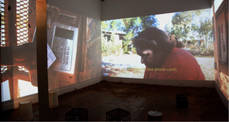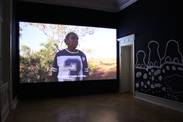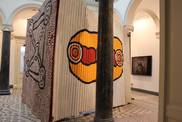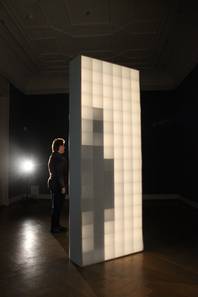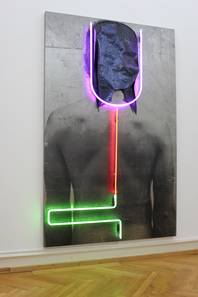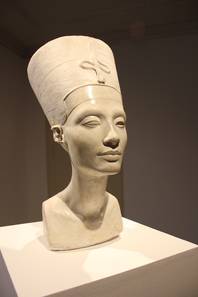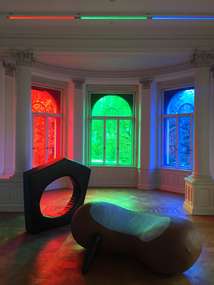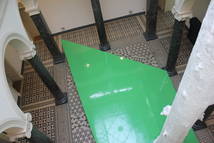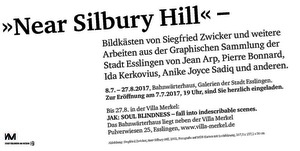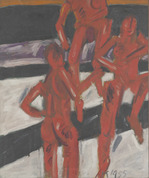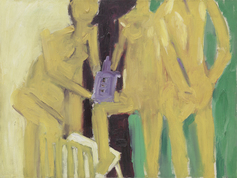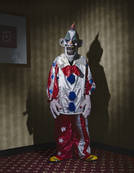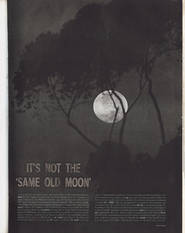December 21th – March 4th, 2018
Networking the Unseen
Opening: Wednesday, December 20th, 7 pm
Networking the Unseen is an exhibition that brings together works from contemporary Indigenous and Australian artists with works by media and digital artists from the European scene. Through the disparate culturally, geographically, and socially dependent frameworks visible in the works, the two-way interaction between culture and technology is brought into focus.
In this historical moment of intense, rapid, and widespread transformation as a result of digitalisation, the exhibition presents artists who are grappling with the ramifications of advancing technologies on cultural traditions, nature, art, the individual, and the society within which they live. Networking the Unseen achieves an unusual breadth of perspective on a set of issues that, after all, affects every community around the world today. The exhibition takes stock of the extent of cultural change and proposes strategies for a reorientation of our relationship to technology.
There will be different events accompanying the project at Villa Merkel during the runtime of the exhibition.
Artists:
Nora Al-Badri & Jan Nikolai Nelles (D), Brook Andrew (AUS), Aram Bartholl (D/NL), Neil Jupurrurla Cook (AUS), Michael Erglis (AUS), Jenny Fraser (AUS), Barbara Herold & Florian Huth (D), Lily Hibberd (AUS), Agnes Jänsch (D), Gretta Louw (D/AUS), Owen Mundy (USA), Katrin Petroschkat (D), plan b (D/GB), Anahita Razmi (D), Curtis Taylor (AUS), Addie Wagenknecht (A/USA), Nine Yamamoto-Masson (F/J) und aus dem Warnayaka Art Centre (AUS)
Curator: Gretta Louw
November 15th – November 26th, 2017
GröKaZs
Postgraduate students from the Weißenhof-Programm of the Stuttgart State Academy of Art and Design
Opening: Tuesday, November 14th, 7 pm
The postgraduate students from the Weißenhof-Programm of the Stuttgart State Academy of Art and Design (2016/2017) present their latest works and projects at Villa Merkel in Esslingen from November 15th 2017.
The presentation is titled "GröKaZs" and will be festively opened on Thuesday, November 14th 2017, 7pm, by Holger Bunk, professor for painting and chairman of the program committee, and Andreas Baur, director of Villa Merkel, gallery of the city of Esslingen.
The graduates Gala Adam, Lilith Becker, Márton Dés und Charlie Stein titled their presentation "GröKaZs", meaning "Größte Künstler*innen aller Zeiten" (greatest artists of all time). This ironic acronym represents the ironical exaggeration of the grandest and best of all times. That is why the four "greatest artists of all time" will present the viewers nothing less than the "greatest art of all time" at Villa Merkel, at the same questioning to which extent perception and hope of this kind has established in art- and cultural institutions or if these promises of the market and institutions threaten them to go astray in the wrong direction.
In der Villa Merkel werden Werke und Projekte der Meisterschüler*innen zu sehen sein, die vor Ort temporär inszeniert werden sowie Malerei, Objektkunst, Video- und Soundarbeiten. "GröKaZs" bildet den Höhepunkt und Abschluss des postgradualen Studiengangs "Meisterschüler des Weißenhof-Programm der Bildenden Kunst", in dem herausragende Künstlerinnen und Künstler innerhalb eines Jahres ein intensiv betreutes Vorhaben umsetzen und damit den akademischen Grad der "Meisterschülerin/Meisterschüler der ABK Stuttgart" erlangen. Mit der aktuellen Ausstellung knüpfen die Hochschule und die Villa Merkel an die erfolgreiche Kooperation vor allem auch des vergangenen Jahres an, als bereits die damalige Präsentation unter dem Titel "Practice Process Progress" in Esslingen sehr erfolgreich und bei großem Publikumszuspruch gezeigt wurde.
Die Villa Merkel wird mit dieser Kooperation in geradezu idealer Weise auch in besonderer Weise dem Anspruch und Leistungsauftrag gerecht, innovative künstlerische Positionen zu fördern, Neues auf den Weg zu bringen und diesem eine breite Plattform zu bieten. "GröKaZs", die Schau der jungen künstlerischen Positionen, wird durch ein umfangreiches Rahmen- und Begleitprogramm aus Performances, Konzerten, Künstlergesprächen oder Diskussions-Panels ergänzt, dessen einzelne Programmpunkte zeitnah bekannt gegeben werden.
June 18th - August 27th, 2017
JAK: SOUL BLINDNESS
fall into indescribable scenes
Opening: Sunday, June 18th, 11 am
JAK is anonymous.
JAK will only show artistic work.
However, JAK emerged in many ways over the last years - as an artist, author, psychotherapist, religious academic, an right now; JAK focusses on its film project SOUL BLINDNESS which lends its title to the exhibition at Villa Merkel. JAK is also a director and screenwriter. JAK's artistic work develops highly complex and follows an etremely precise conceptual concisness.
JAK is working on the film since 2013. The process of development differs from that of a normal, structured film shoot. Throughout ongoing exhibition activity, JAK writes the story of the script step by step, continuing it with each exhibition. In the process, JAK employs media such as drawing, text, video, sound, sculpture, painting, photography or installation.
It revolves around the phenomenon of the psychological anomaly agnosia - the soul blindness. Acts from the script of SOUL BLINDNESS transform and concretize for the exhibition to stages and sceneries inviting you to dive into the visualized intellectual world of JAK.
In the entrance hall of Villa Merkel, an old tree towers as a sculpture seven meters above the ground. It is supported by a bright green, reflective surface made of epoxy resin, positioned diagonally.
Elsewhere, a landscape of flowing fog and floating porcelain objects suggests scenery from the screenplay of the film. Typographical paintings on canvas conceal texts in geometric abstractions. Spliced and mirrored texts reflect the conceptual treatment of a medical book. Hundres of scenic miniature drawings, molded in epoxy as if preserved, tell a story or show the way.
But who is JAK anyway? JAK neither shows a body or a coherent character - JAK transports identity through different artistic expressions and mirrors realities. Who JAK is remains the question - JAK forces the eye of the observers solely on the artistic work - somewhere between reality and phantasy.
The exhibition at Villa Merkel follows the exhibitions HUNTING at the Württembergischer Kunstverein in Stuttgart; PROLOG at the Kuandu Museum of Fine Arts in Taipei, and CUT TO:, at Galerieverein, Leonberg, and is therefore the fourth solo exhibition related to this complex project from JAK. As a prelude to the exhibition in Esslingen, an initial exhibition took place at the Baden-Württemberg State Office of Representation in Brussels on March 2nd 2017.
The catalog for the exhibition is published by Snoeck Verlagsgesellschaft, Cologne.
July 08th – August 27th, 2017
Bahnwärterhaus:
Near Silbury Hill
Pictureboxes by Siegfried Zwicker and additional works from the graphic collection of the city of Esslingen
Opening: Friday, July 07th, 7 pm
The galleries of the city of Esslingen present the latest aquisitions and beneficences from the graphic collection at the Bahnwärterhaus on July 8th until August 27th. Pictureboxes by Siegried Zwicker are the centre of the presentation and set in a dialogue with works by Jean Arp, Pierre Bonnard, Ida Kerkovius, Ernst Ludwig Kirchner, Henry Moore and many more as well as current, international positions of contemporary art by Willie Doherty and Anike Joyce Sadiq.
Landscape spaces in the South of England and room landscapes of Hungarian offices, deep spaces of the homey boudoir and the world of abstraction - how we preceive spaces, charged with or constructed on the surface? The variety of aspects concerning this topic will be discussed through the artists in fotographs, Objects, drawings and prints.
The exhibition Near Silbury Hill is in refrence to previous presentations of the collection such as Das alles auf Papier! (2007), kein licht für wen (2008) or Obsessionen und surreale Welten (2014/15)
The show was curated Andreas Baur, director of Villa Merkel, galleries of the city of Esslingen am Neckar, and Julia Herrmann, project manager.
March 19th – May 28th, 2017
Allan Kaprow – Painting 1946–1957, a Survey
Opening: Sunday, March 19th, 11 am
Allan Kaprow (1927–2006) is renowned throughout the world especially as an action artist. Not only can the idea of happenings be traced back to him, inasmuch as he had a deciding influence on this art form at the end of the 1950s. His happenings and environments – gigantic, movable installations made of such things as car tires, barrels or blocks of ice – are also considered milestones in the recent history of art. It is this dimension that was honored in a particular manner in 2006 by the Haus der Kunst in Munich with the exhibition Art as Life.
However, Kaprow began as a painter, not least during his studies with Hans Hofmann. He also studied with the art historian Meyer Shapiro and the composer John Cage, early on displaying a readiness to traverse artistic and theoretical boundaries. It was a time when the range of artistic materials was expanding: visual art materials came from industry and from everyday life, silence and noise expanded the scope of music, and everyday human interactions entered choreography and dance.
The exhibition at the Villa Merkel in Esslingen is the first to focus exclusively on the early paintings that the artist created between 1946 and 1957. It provides visual evidence of the young artist’s orientation and his investigation of existing creative models, as well as his interest in questions of space – inspired by the exemplary notion “push and pull” formulated by Hans Hofmann – and his endeavor to bring the achievements of figures like Jackson Pollock and John Cage into mutual, even merged relation. Arising against this background starting in the mid-1950s are the works he called “action collages,” in which he gradually came to include everyday materials and objects.
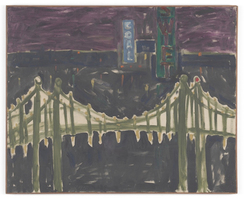
Allan Kaprow, George Washington Bridge, 1955, Oil on canvas, 97,2 x 119 cm, © Allan Kaprow Estate, Courtesy Hauser & Wirth, Photo: Stefan Altenburger Photography Zürich
Influenced by Jackson Pollock’s focus on the primacy of action, Allan Kaprow set himself the goal of producing his collages as rapidly as possible and simultaneously linking them to musical structures that he had previously transformed into colored material. The artist’s crucial further development of the action collages into environments acquired palpable form for the first time in the Rearrangeable Panels (1957–1959), a multipartite work of canvases capable of being arranged into various forms. He created them in 1959 as an integral part of 18 Happenings in 6 Parts at the Reuben Gallery in New York.
Proceeding from these early pictures and adhering to a stringent conceptualization, Allan Kaprow profiled his perspective in a thoroughly precise form and thereby opened up new dimensions of artistic expression. In his happenings, he broke through the borders between painting, object, installation and performance. This situates him in a dynamic field of intuition, open form and temporal anchoring on the one hand, and a reflective practice as theoretician and art historian on the other.
The exhibition in Esslingen will present a broad spectrum of pictures never before on public display. Pictures which, already at the beginning of an artistic oeuvre, point with unswerving logic far beyond the customary borders between genres. In this sense, it extends a referential arc in the program of the Villa Merkel to such presentations as Survey by Manfred Kuttner, an artist whose paintings from the 1960s – the pictures could be seen at such shows as the influential Demonstrative Ausstellung (Demonstrative Exhibition) in Düsseldorf mounted by Kuttner together with Polke, Richter and Lueg – were ultimately developed further into completely other dimensions.
The exhibition Allan Kaprow – Painting 1946–1957, a Survey is being realized in collaboration with the Allan Kaprow Estate and Hauser & Wirth. A catalogue will be published.
March 19th – May 28th, 2017
Stories in Your Mind
Opening: Sunday, March 19th, 11 am
The exhibition Stories in Your Mind presents various positions of contemporary art that address the theme of narrativity. It focuses on the interaction between viewer and work of art: What characteristics of the artwork in terms of its medium and contents inspire the recipient's power of imagination? Which artistic strategies develop a narrational impact?
Narrative elements are typical of a large number of works of contemporary artistic production. Their utilization does not inherently involve the communication of a story that is complete in itself, as in a feature film, for example. Instead fragmentary structures are created which allow a free artistic treatment. In the form of impulses, they can be described as stimuli that trigger a process of imagination in the viewer. The degree to which the viewer feels a work of art to be narrational or not depends fundamentally on his cultural conditioning and is always subjective as well. Thus the narrative impact does not depend solely on the artistic intention, but to an equal degree on the recipient who responds to the offered impulses through processes of memory, fantasy or emotionalization, for example.
Nevertheless, certain characteristics of an artistic work with regard to its medium and contents enhance its power of narration. A vivid effect is achieved, for example, by moving pictures, by the use of language in written or verbal form, by music as well as by the pictorial or linguistic thematization of figures.
Videos and conceptual combinations of photographs and texts accordingly provide great narrative potential. But also the depiction of empty, uninhabited spaces can inspire the imagination of the viewer, because the representation of time and the constitution of space, for example, can as basic elements for shaping a framework give rise to mental narrative processes.
A further elaboration of the exhibition's theme is an investigation of narration in such modes as the use of writing as a sculptural form and also the medium-specific rearrangement of textual interconnections.
Artists:
Natalie Czech, Jonas Dahlberg, Christian Jankowski, Sven Johne, Katrina Palmer, Maximilian Schmoetzer
Curator: Clea Laade
May 13th – May 28th, 2017
Alberto Zamora Ruiz – it's happening!
Opening: Friday, May 12th, 7 am
In the past weeks, the function of the “Bahnwärterhaus,” a former signalman’s house, has been expanded transforming one floor to a temporary studio for the painter Alberto Zamora Ruiz. He will now present the results of his stay in the exhibition “it’s happening!” which will run from the 13th to 28th of May featuring additional works by the artist.
In his painting practice, Alberto Zamora Ruiz deals with phenomena in the internet’s grey areas. On channels such as Facebook, Youtube, 4chan, or Reddit, the artist follows the emergence of an increasingly complex internet culture that assigns its own terms to trends and user behaviours, essentially developing its own language.
With the search word “Battlestations,” for example, one can find a plethora of photographs of home computer workstations on the internet. The term initially referred to the workstations of gamers who actually use their computer setups for “battle.” Meanwhile, however, it is used more generally for the configuration of a computer, monitor, and accessories. Internet users celebrate their hardware as a door to virtual worlds. Between the bright digital promise of glaring computer screens and the lonely sadness between cables, Alberto Zamora Ruiz documents these stations.
Alberto Zamora Ruiz, Battlestation, 2016, Serie, ca. 95 x 70 cm, Öl auf Papier, Graphische Sammlung der Stadt Esslingen am Neckar
Alberto Zamora Ruiz, Battlestation, 2016, Serie, ca. 95 x 70 cm, Öl auf Papier, Graphische Sammlung der Stadt Esslingen am Neckar
The trend of the “reaction video,” in which people record themselves watching series or movie trailers, can be seen as an escalation from the ubiquitous selfie. On the living room couch, it is a matter of producing the best facial expression for what is happening on screen. Reaction videos may be clicked on millions of times. With his paintings, the artist draws the viewer back to the real individuals behind the seemingly virtual occurrences.
As the blending of virtuality and reality takes on an increasing weight in our everyday lives, Alberto Zamora Ruiz devotes himself to a precise study of individual phenomena in internet culture, absurd as they may seem, and creates the possibility of approaching these confusing developments.
Alberto Zamora Ruiz (*1982, Mexico City) lives in Stuttgart. He studied with Holger Bunk at the Akademie der Bildenden Künste Stuttgart and was recently awarded a grant in Mexico City (FONCA-Grant 2016 – Fondo Nacional para la Cultura y las Artes, México).

